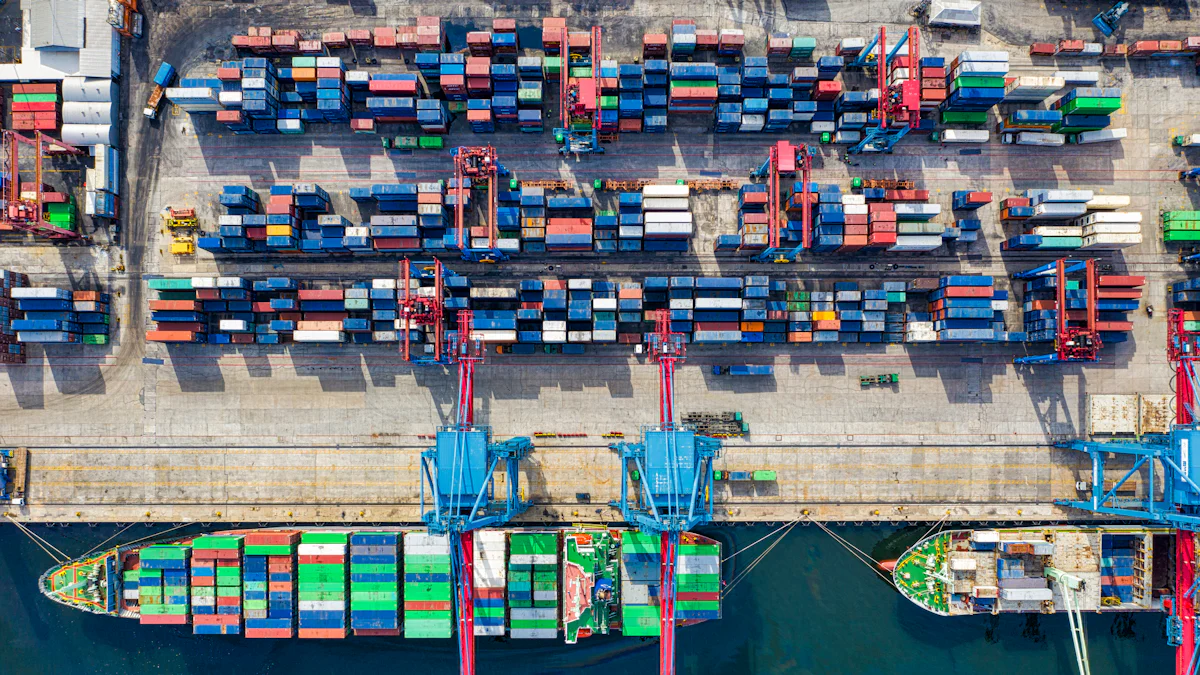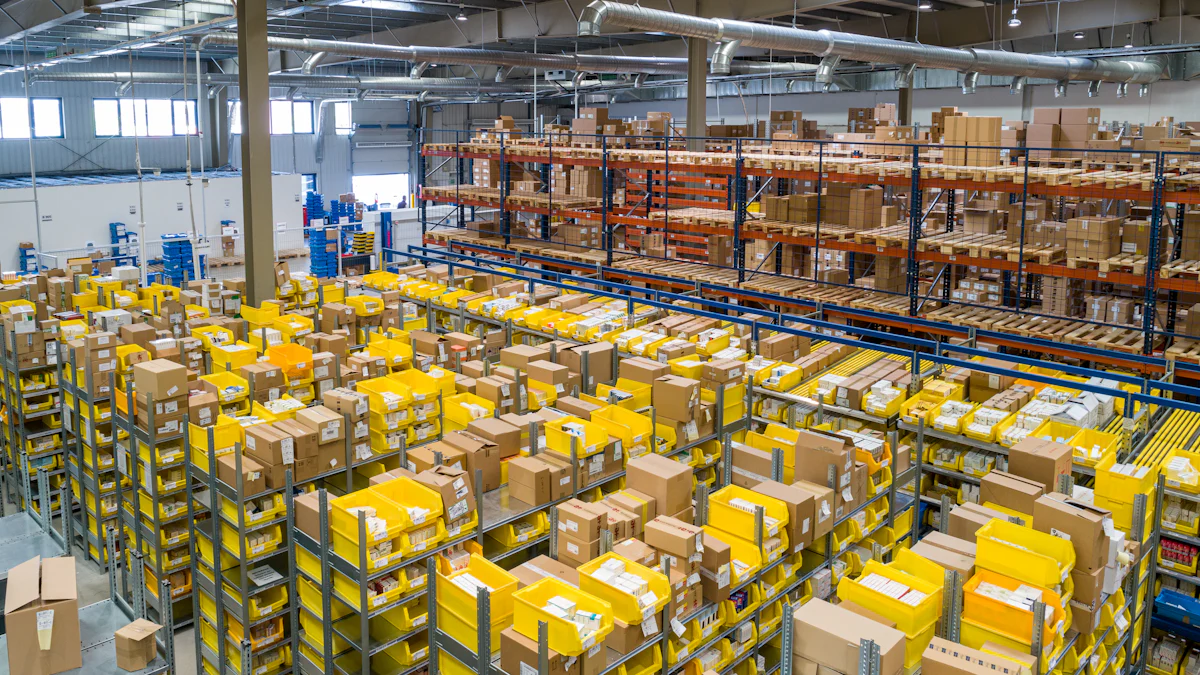Global Warehousing Strategy

Global warehousing involves the strategic placement of storage facilities worldwide to support international trade. These warehouses play a crucial role in modern supply chain management by ensuring efficient storage and distribution of goods across borders. The evolution of global warehousing dates back to the Industrial Revolution, which introduced significant changes with the advent of manufacturing and mass production. Today, advancements in technology and logistics have made global warehousing indispensable for businesses aiming to meet global demand.
Understanding Global Warehousing
Basic Concepts
Definition and Scope
Global warehousing involves the strategic placement of storage facilities worldwide to support international trade. These warehouses play a crucial role in modern supply chain management by ensuring efficient storage and distribution of goods across borders. The evolution of global warehousing dates back to the Industrial Revolution, which introduced significant changes with the advent of manufacturing and mass production. Today, advancements in technology and logistics have made global warehousing indispensable for businesses aiming to meet global demand.
Key Components
Key components of global warehousing include:
Storage Facilities: These range from automated warehouses to temperature-controlled environments.
Inventory Management Systems: Advanced systems ensure real-time tracking and efficient stock control.
Logistics Networks: Integrated networks facilitate smooth transportation across borders.
Security Measures: Robust security protocols protect high-value goods and sensitive materials.
Historical Context
Evolution of Warehousing Practices
Warehousing practices have evolved significantly over time. The early 20th century saw basic storage solutions primarily focused on local markets. The mid-20th century introduced more sophisticated methods due to increased industrial activity. By the late 20th century, globalization necessitated advanced warehousing strategies to manage international trade effectively.
Impact of Globalization
Globalization has profoundly impacted warehousing practices. Companies now require strategically located warehouses to meet global demand efficiently. This shift has led to an increase in specialized facilities such as bonded warehouses and cold storage units. Moreover, technological advancements like automation and data analytics have further enhanced operational efficiency.
Benefits of Global Warehousing

Operational Efficiency
Reduced Lead Times
Global warehousing significantly reduces lead times. Strategically placed warehouses ensure that goods reach their destinations faster. This efficiency minimizes delays and enhances the overall supply chain performance. Companies can meet customer demands promptly, which is crucial in today's fast-paced market.
Improved Inventory Management
Advanced inventory management systems play a vital role in global warehousing. These systems provide real-time tracking and accurate stock control. Businesses can avoid overstocking or stockouts, leading to optimal inventory levels. Efficient inventory management also reduces waste and improves resource utilization.
Cost Advantages
Economies of Scale
Global warehousing offers substantial cost advantages through economies of scale. Large-scale operations allow businesses to reduce per-unit costs by spreading fixed costs over a larger volume of goods. Bulk purchasing and storage further lower expenses, making global operations more cost-effective.
Lower Transportation Costs
Strategically located warehouses help in lowering transportation costs. Proximity to key markets reduces the distance goods need to travel, cutting down on fuel and labor expenses. Efficient logistics networks ensure smooth transportation, minimizing additional costs associated with delays or rerouting.
Market Responsiveness
Faster Delivery Times
Faster delivery times are a significant benefit of global warehousing. With warehouses located near major markets, companies can expedite order fulfillment processes. Quick deliveries enhance customer satisfaction and build brand loyalty, giving businesses a competitive edge.
Enhanced Customer Satisfaction
Enhanced customer satisfaction results from efficient global warehousing practices. Reliable and timely deliveries meet customer expectations consistently. Advanced technologies like automation and data analytics improve accuracy in order processing, reducing errors and returns.
Challenges in Global Warehousing
Logistical Complexities
Coordination Across Borders
Global warehousing involves intricate coordination across multiple countries. Each country has unique logistical requirements. This complexity demands precise planning and execution. International warehouses must align with diverse transportation networks to ensure efficient movement of goods. The strategic location of these warehouses in key transportation hubs optimizes cross-border efficiency.
Regulatory Compliance
Regulatory compliance presents another significant challenge in global warehousing. Different countries enforce various import and export regulations. Warehouses must stay updated with these ever-changing rules to avoid legal issues. Compliance includes adhering to customs procedures, tariffs, and trade agreements. Failure to comply can result in fines, delays, or confiscation of goods.
Cost Management
Initial Setup Costs
Setting up a global warehousing network incurs substantial initial costs. Businesses need to invest in land acquisition, construction, and infrastructure development. Specialized facilities such as temperature-controlled or automated warehouses require additional capital investment. These high upfront costs can be a barrier for many companies.
Ongoing Operational Expenses
Ongoing operational expenses also pose a challenge in global warehousing. Maintenance of advanced systems and equipment requires continuous funding. Labor costs vary by region but often represent a significant portion of operational expenses. Energy consumption for climate control and automation further adds to the cost burden.
Technological Integration
Need for Advanced Systems
Technological integration is crucial yet challenging for global warehousing operations. Advanced systems like Warehouse Management Systems (WMS) enhance efficiency but require significant investment and expertise to implement effectively. Many warehouses lack automation; 80% do not possess any automated systems, which hinders operational efficiency.
Data Security Concerns
Data security concerns are paramount in the realm of global warehousing due to the reliance on digital systems for inventory management and logistics coordination. Protecting sensitive information from cyber threats necessitates robust cybersecurity measures, which involve both financial investment and specialized knowledge.
Technological Advancements in Global Warehousing

Automation and Robotics
Automated Storage and Retrieval Systems (AS/RS)
Automated Storage and Retrieval Systems (AS/RS) revolutionize global warehousing by enhancing efficiency. These systems use advanced machinery to store and retrieve goods with precision. Companies benefit from reduced labor costs and increased storage density. The automation minimizes human error, ensuring accurate inventory management.
Use of Drones and AGVs
Drones and Automated Guided Vehicles (AGVs) play a crucial role in modern warehouses. Drones conduct aerial inspections, providing real-time data on inventory levels. AGVs transport goods within the warehouse, streamlining internal logistics. This technology reduces manual handling, improving safety and operational speed.
Data Analytics and AI
Predictive Analytics
Predictive analytics leverages historical data to forecast future trends. Warehouses use this technology to anticipate demand fluctuations. Accurate predictions enable better inventory planning, reducing stockouts or overstock situations. Businesses can optimize their supply chain strategies based on these insights.
Real-time Inventory Tracking
Real-time inventory tracking uses sensors and software to monitor stock levels continuously. This system provides instant updates, allowing businesses to respond quickly to changes in demand. Efficient tracking ensures that products are always available when needed, enhancing customer satisfaction.
IoT and Smart Warehousing
IoT-enabled Devices
Internet of Things (IoT)-enabled devices connect various warehouse components for seamless communication. Sensors collect data on environmental conditions, equipment status, and inventory levels. This connectivity enhances operational visibility, enabling proactive maintenance and efficient resource management.
Smart Sensors and RFID
Smart sensors and Radio Frequency Identification (RFID) tags offer precise tracking capabilities. These tools monitor the movement of goods within the warehouse accurately. RFID tags provide detailed information about each item’s location and status. Smart sensors detect changes in temperature or humidity, ensuring optimal storage conditions for sensitive products.
Best Practices for Effective Global Warehousing
Strategic Location Selection
Proximity to Key Markets
Selecting warehouse locations near key markets enhances operational efficiency. Companies can reduce transportation costs by minimizing the distance goods travel. This proximity ensures faster delivery times, which boosts customer satisfaction. Businesses should analyze market demand patterns to identify optimal locations.
Accessibility to Transportation Networks
Warehouses must have easy access to major transportation networks. Proximity to highways, ports, and airports facilitates smooth logistics operations. Efficient connectivity reduces transit times and lowers fuel consumption. Companies should evaluate infrastructure quality when choosing warehouse sites.
Efficient Inventory Management
Just-in-Time (JIT) Inventory
Implementing Just-in-Time (JIT) inventory systems optimizes stock levels. JIT minimizes excess inventory by aligning production schedules with demand forecasts. This approach reduces storage costs and improves cash flow management. Businesses benefit from increased flexibility in responding to market changes.
Safety Stock Levels
Maintaining appropriate safety stock levels prevents stockouts during unexpected demand surges or supply chain disruptions. Safety stock acts as a buffer against uncertainties in supply and demand fluctuations. Companies should use data analytics to determine optimal safety stock quantities based on historical trends.
Leveraging Technology
Warehouse Management Systems (WMS)
Warehouse Management Systems (WMS) enhance operational efficiency through automation and real-time tracking. WMS streamlines inventory management, order processing, and shipping activities. Advanced features like barcode scanning and RFID technology improve accuracy in inventory control.
"Technology advancements have elevated the efficiency and accuracy of warehouse operations to unprecedented levels."
Businesses should invest in robust WMS solutions tailored to their specific needs.
Integration with Supply Chain Management (SCM) Software
Integrating Warehouse Management Systems with Supply Chain Management (SCM) software creates a seamless flow of information across the entire supply chain. This integration enables better coordination between different stages of the supply chain process, from procurement to distribution.
Enhanced visibility into inventory levels
Improved demand forecasting
Streamlined order fulfillment processes
Reduced lead times
Companies achieve greater agility and responsiveness through this integrated approach.
Global warehousing plays a pivotal role in modern supply chain management. Businesses benefit from reduced lead times, improved inventory management, and cost advantages. However, logistical complexities and regulatory compliance present significant challenges. Technological advancements like automation and data analytics help overcome these obstacles.
"The global warehousing market is expected to expand at a compound annual growth rate (CAGR) of 10.5% from 2021 to 2028."
Future trends indicate increased demand for logistics services driven by e-commerce growth and advanced technologies. Companies should consider strategic location selection, efficient inventory management, and leveraging technology to optimize their global warehousing operations.
See Also
Enhancing Productivity: JUSDA Unveils State-of-the-Art Warehouses
Boosting Efficiency: Understanding Robotics in Warehouse Operations
The Importance of Automation in Business Warehousing
Logistics Robotics: Revolutionizing Warehouse Efficiency
Automated Future: Exploring Benefits of High-Tech Warehousing
